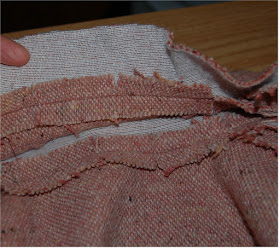1) Pretreat fabrics.
Wool Coating Fabric
Flannel-backed sating lining (Kasha)
I love shopping for fabrics. I hate pretreating them. I'm sure I'm not the only one who feels this way. But there is no getting around this initial step. There are so many helpful info online on how to pretreat fabrics. I chose to preshrink my wool fabric in the dryer instead of steaming it on the ironing board or bringing it to the dry cleaners. I threw it in with two damp bath towels and set the dryer to medium heat for 30 minutes. I did the same thing with the satin lining.
2) Interfacing
Pro-Weft Fusible Interfacing
To be honest, I have never thought about preshrinking interfacing. I've been lucky so far. None of the interfaced yokes of my past skirt projects did not seem to pucker after washing. But I decided to do it differently here. I was committed to prewashing my interfacing until I learned about Fashion Sewing Supply. The owner has great tutorials on her website and she sells professional grade interfacing that don't require any pretreatment at all. So I was sold!
3) Tools
Unlike Ina Garten who does not recommend buying kitchen tools that don't multitask, I like gadgets, sewing gadgets that is. As long as they will help make my sewing look more professional, I don't mind investing.
Walking Foot
This foot is probably one of the more versatile ones in my sewing closet. I originally bought this for my quilting projects but I find myself reaching for this more often than not while sewing apparels. It makes sewing slippery fabrics like silk less frustrating. Same with wool. My fabric was quite thick and using this walking foot ensured an even feeding.
Buttonhole foot
I was dreading the part where I had to start sewing buttonholes on the coat. The fabric frayed easily and I knew there was no room for ripping any stitches at this point. I knew I would end up with a mess and I was sure my coat would end up in the bin of failed or never-finished projects. I considered doing bound buttonholes but I've never done it before and after reading tutorials on it, I thought my fabric was not suitable. But to my pleasant surprise, all the buttonhole stitches turned out perfect!
Buttonhole Cutter and Snip Scissors
Of course, no matter how perfect the buttonhole stitches are, if you don't have the right tools to cut, it will still end up in a mess. I have had this buttonhole cutter set for the longest time. And the super slim blade of the snipping scissors is perfect for making small precise cuts through the threads.
It goes without saying to use the appropriate machine needle and thread. And of course, one can never sew without a good iron on the side.
4) Seams
I did not bother to finish the seams of my coat or lining as they were going to be hidden inside the lining anyway. But next time, I will definitely finish the seams on the hem. When it was time to sew the hems together, the wool fabric started fraying and I am not sure with time how well the fabric will hold up to the pull of the lining.
It is also important to press open the seams after stitching. I used a scrap piece of fabric for my pressing cloth and the wool responded to ironing with steam beautifully.



























